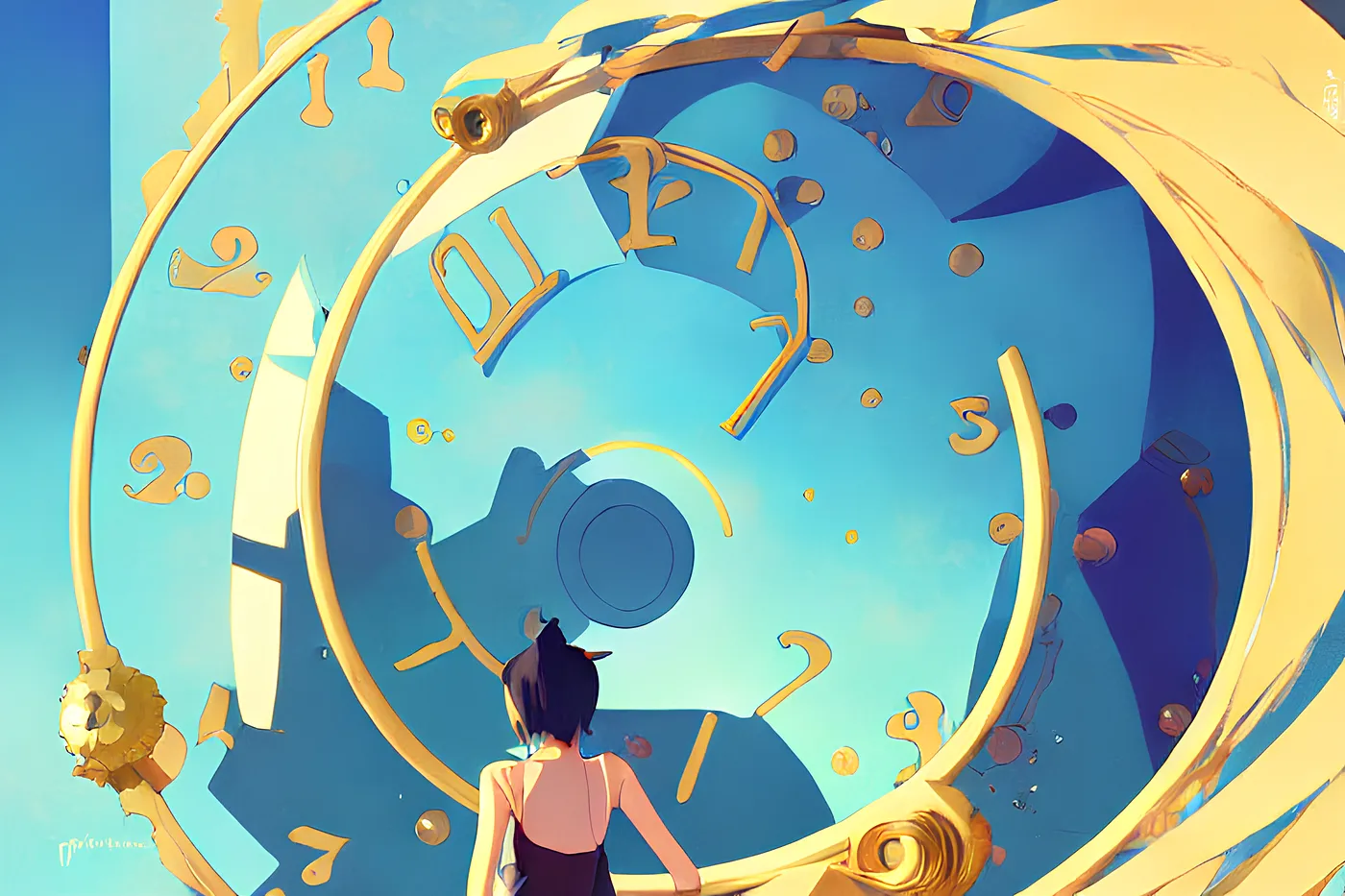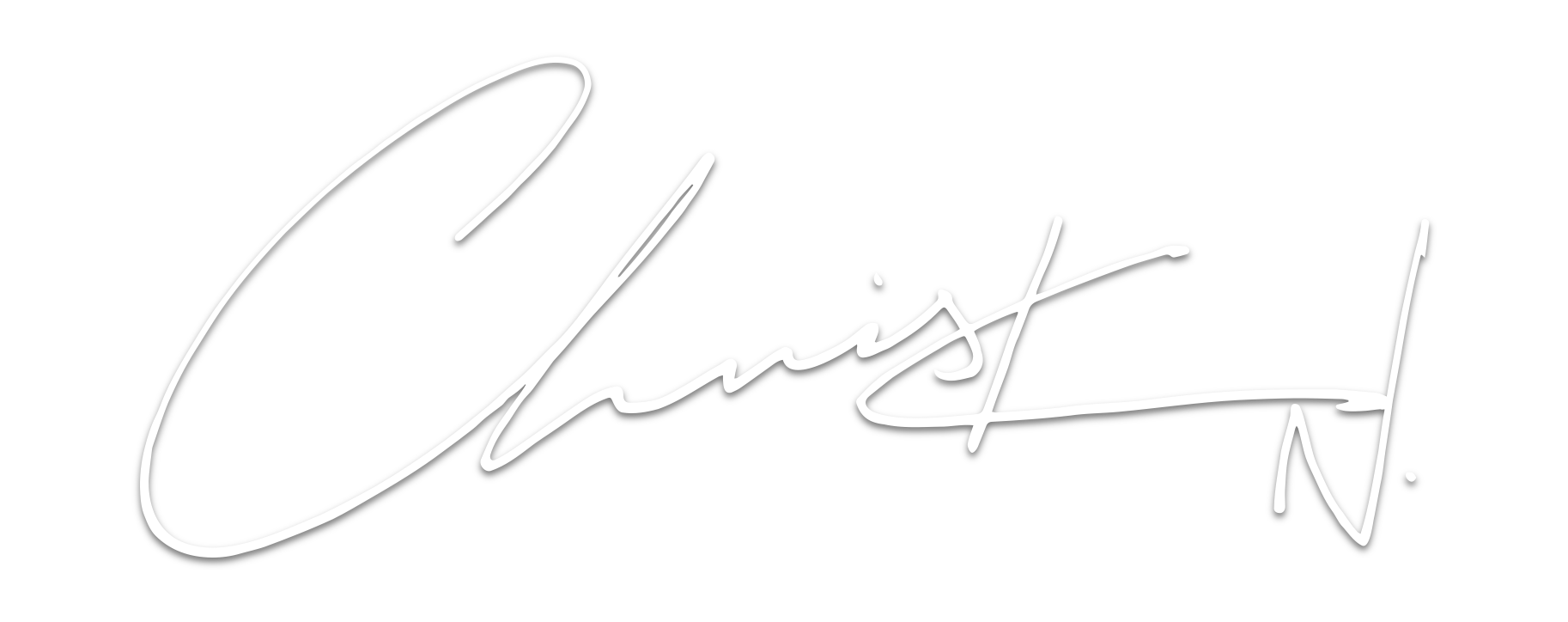
The Way We Think About Time is All Wrong
… and it makes us say and do silly things – like claim that the universe is 14 billion years old or compare ourselves to people born at approximately the same time as us. If we can change how we see time, we can see how silly that is, and maybe add some more time to our lives in the process.
How we (typically) imagine time
If I handed you a pencil and asked you to quickly draw time, how would you do that? What does time “look” like to you?
Most people (including myself on most days) would probably draw some kind of timeline. That’s our go-to picture, at least in the W.E.I.R.D. part of the world: A line, implicitly extending infinitely backward and forward, or maybe up and down.
Others see time as a spiral or a circle, going in an eternal loop. Some imagine something more like a river, or an eternal hourglass, or something entirely different. Some of us see time coming toward us, some see us moving through time, and some see time slipping away.
What all these visualizations have in common, however, is time as a constant motion, as it looks to us on the face of a watch: The never-ending monotonous march of the second hand. A persistent, unchangeable progression, tic, tic, ticking away the moments. Every second, minute, hour, day, year, decade, mercilessly bringing us ever closer to our personal end — and moving on without so much as a flicker when another one of us slips into oblivion.
But that’s a one-dimensional picture of Time.
What we talk about when we talk about time
That one-dimensional perspective on Time is useful for certain tasks, like when we need to coordinate with each other.
It allows for a certain precision that comes in handy. But it clouds our understanding of how time actually works — locally as well as psychologically, in our own day to day lives, and universally, in biology and cosmology.

The thing is: Time is not flat.
On the contrary, time is very uneven. It only looks flat if you never change your perspective on it.
Learning to see time from different angles can help you understand things that haven’t made sense to you before.
You might even learn how to take time apart in your life, and put it back together in new and interesting ways, and almost literally “make time”.
We all know about Time. But how much thought have you given to what Time really means? Have you ever tried to define it?
What are we actually talking about when we talk about Time?
One way to think about it: Time is where change happens. If nothing happens, then nothing changes, and, for all intents and purposes, time stands still.
And vice versa: If time stands still, then nothing changes.
Billiard balls and orbits
From one perspective, that’s all there’s to it. Time is nothing except change. Yesterday we were there, now we’re here, soon we’ll be somewhere else…
Change, in turn, is all about how things relate to each other and affect each other — positions and interactions, causes and effects. If this and this, then that.
Then that, and that, and the next thing … One thing leads to another, like billiard balls shooting across a pool table, knocking into each other.
But notice… The way we think of time in a game of pool — the way we measure progress — is not some flat timeline, with seconds elapsing, one by one.
What matters in the game are the changes that happen on and around the table. The number and order of turns and shots the players make, and the number of balls left on the table.
For the purposes of the game itself, it doesn’t matter much if the game takes ten minutes, ten hours or ten days (though the players may get impatient if it drags on).
All that matters for understanding the progress of the game, is to see how the position of the balls change, relative to each other and to the table.
And that’s how time works on a larger scale, too: All that matters when we talk about time, is how things move relative to each other — how the earth moves relative to the sun, the moon relative to the earth, and where you are and how fast you are moving relative to your next appointment.

So in order to understand time, we need to understand change.
Two kinds of change
Time, in the sense we care about, is born in the tension between two types of change: Order, which is predictable, repetitive, and infinitely unsurprising, and Chaos, which is entirely unreliable and follows no discernible rules or patterns.
At either extreme, time loses all meaning. Really. Anything and everything interesting happens where Chaos and Order collide.
Pure Order
Pure Order is entirely predictable. It’s a pattern that never breaks, never varies, never stops.
Imagine a bullet with nothing to stop it. Going in a straight line, with nothing to hit. No gravity. No friction. Nothing to slow it down.
That is perfect predictability. Pure Order. It follows Newton’s first law: An object in motion will remain in motion, unless acted upon by an external force.
With nothing to relate to, the bullet will remain in motion, forever moving through an infinite void. And so it doesn’t really matter that it is moving.
With nothing to relate to, it has no meaningful speed, no meaningful direction. Without something to change in relation to, it doesn’t really change at all. No more than a bullet that doesn’t move at all.
And that’s not just true for a single bullet. You can imagine a thousand bullets, travelling parallel to each other, at the same speed. They might as well be standing still, for all the difference it makes.
Time might as well be standing still.
Pure Chaos
Pure Chaos — constant and entirely unpredictable change — is equally devoid of meaning.
When nothing is predictable and nothing lasts, everything changes all the time in ways that follow no rules. There is no direction, no progress, no growth.
Sure, things may always be changing, but the change never really goes anywhere. It doesn’t mean anything.
It’s like the sound of your FM radio between stations, or the picture on your old TV set with the rabbit-ear antenna, when it receives no signal.
Even if, against all odds, a seemingly meaningful sound or picture emerges from the noise for one split second, it will be gone in the very next moment with no evidence it ever happened, and no impact. It might as well never have existed.
Time might as well never have existed.
It’s all in the tension
And so, the concept of time doesn’t make much sense in either case. Everything we care about happens in the tension between Order and Chaos.
In order for anything meaningful to happen — evolution, adaptation, emergence of new things — we need Order in tension with Chaos: Repetitive, but not entirely predictable.
Order, such as repeated iterations of the same event, over and over–like the drip, drip, drip of water–is nothing without a little Chaos.
Meaningful time, change and creation all happen when the water collides with something, like a rock’s surface.
That’s when the drip, drip, drip becomes a puddle, a pool, an ever deeper groove where the pool overflows.
That’s where time, as we know it, is created. And everything else we care about, too.
Another hint of Chaos — a crack in the surface, a breath of wind, a change in temperature, tiny variations over hours and seasons and years — makes the puddle unique, irregular, unlike any puddle that has ever existed before and any that will ever exist again.

A bit of repetition – to make it stick
This is really important to understand, because its implications run deep – from how our most trivial habit build us, to how the universe itself is shaped, and how life can flourish.
Order builds things. Within the tension, repetition creates scale, direction, momentum. Repetition sharpens the blade, deepens the cut. Sooner or later, enough repetitions will reach any reachable limit.
Chaos breaks the pattern, and disrupts the monotony. It makes things unique and unpredictable. It creates variation, novelty, identity. The infinite variation of Chaos guarantees that we will never reach the end.
It’s where they meet things get interesting: That’s where galaxies collide, where life evolves, where weather arises. It’s the tension that makes the difference between random sounds and a song, between ordinary and beautiful, even between dead and living.
It’s in that tension we get all the change that we experience as the passage of Time.
There’s no “perfect” balance
This may seem like a spiritual or mystical point. It is not.
I use words like “meaningful” and “predictable” in a way that may make it seem as if those are objective values in the universe, but they are not.
There is no ideal balance to be struck between Order and Chaos. Nor is there reason to think any part of the Cosmos (except us) cares about finding such a balance.
If it seems that way, that is because our lives depend on the particular balance we happen to be living in, and everything we find meaningful or beautiful comes out of that balance.
The reason it seems so perfect to us, is that we evolved to fill a groove that was carved over billions of years, long before we were born.
It is only perfectly designed to us in the way the trunk of a tree is the perfect place to hide for the bugs in the picture below. (Can you see them?)
As we know, it’s not so much the trunk that is perfectly designed to accommodate the bugs, as it is the bugs that have evolved to blend into the background.

Similarly, humans have evolved to fit neatly into the background pace of change in our particular corner of the galaxy. And so, when I use words like meaningful or beautiful, I am aware that meaning and beauty are in the eyes of the beholder.
But so is Time.
What does this mean for the Universe?
That then, is what we experience when we experience Time: The monotonous rhythm of the universe, broken up by irregularities that make us pay attention.
But in what sense does that mean the Universe is not really 14 billion years old?
Of course, I don’t dispute the observations or calculations made by our most brilliant astrophysicists. I’m sure there is a sense in which it is entirely true to say that the Universe is 14 billion years old.
But as a fact, it is only true in a shallow and trivial way — in the same way that the subway map above is an accurate representation of New York City. It doesn’t really mean anything.
The problem with saying that our universe is 14 billion years old, is that a “year” is a very particular thing — a very particular rhythm. For most of the Universe’s existence that rhythm didn’t exist. And in most of the Universe, it still doesn’t.
A year is one trip for the Earth around the sun in a slightly elliptical orbit, at a particular speed, coinciding with Earth rotating ~365.26 times on its axis while being tilted 23.5 degrees relative to the plane of the orbit, while also being orbited ~13 times by a moon of a particular size.
All these repetitions, on constant repeat, and slightly out of sync with each other, create an intricate pattern of change–days, months and seasons, tides and winds. Infinite tiny variations on a pretty basic theme.
When we say that Earth is billions of years old, we mean that Earth has been through billions of those cycles. Billions of winters and springs and summers and falls. Trillions of days when the temperature has risen and fallen, and the tide has come and gone.
That is time–at least in any sense that matters. It’s not how far we are from the center or the edge, but how many iterations we have gone through, how many drops have dripped, and how deep and long the resulting groove has become.
Without all those repetitions, and all the slight variations, there would be no weather, no life, no evolution, no us … None of all those big changes we associate with time going by.
And so it sometimes makes sense for human beings to speak to each other about days, months and years… when we talk about our Earth, in our era. But those words don’t mean the same anywhere else, because no other place in space is significantly affected by the rotation of Earth on its axis or the orbit of our moon.
Time is not the same over there.
Put another way: It makes little sense to look at a planet orbiting another star and say “that planet is a billion years older than Earth”.
That can only be correct in the narrowest possible sense, because that other planet doesn’t have Years. We’re comparing two things using a measuring stick that only makes sense to one of them.

If the other planet is tilted differently, or has more than one moon or none at all… If it follows a differently-shaped orbit, or it has significantly higher or lower mass, or it is different in any one of a myriad other ways, then Time itself — or at least everything we care about when we talk about Time — works differently.
Add several such changes together, and you compound the differences until the passage of time becomes unrecognizable.
Time is not the same over there.
When we say a planet is a billion years older than earth, one implication is that life has had a billion more years to develop on that planet. But it hasn’t. Life on that planet has had zero “years” to develop. Instead, it has had a bunch of other iterations. But those iterations may not be as conducive to kickstarting life as our years.
- See We May be Penguins — Thoughts on the Fermi Paradox for more about my thoughts about extraterrestrial life.
Even saying that Earth is 4.5 billion years old is a bit wrong.
Time was very different on Earth back when the planet was young. The moon was much closer to us and was moving much faster, pulling the earth around with it. As far as we know, when the first single-cell life evolved, 3.5 billion trips around the sun ago, one day on Earth only lasted about 12 of our modern hours.
So in those first billion rotations around he Sun, Earth had more than twice as many days and nights, and many more months than today.
You can make the case, then, that those first one billion years were more like two billion years or more. (That is: You can make the case, but it still doesn’t make a lot of sense.)
How long since the Big Bang?
So it doesn’t make much sense to describe the time since the Big Bang as 14 billion years. If you see time as a line, that’s more of a measure of how far light has travelled since the beginning, not everything else that has happened.
But when physicists describe time on this scale, they use something more like a logarithmic scale, going from the unimaginably small to the incredibly large.
They divide the first moments after the Big Bang into minuscule fractions of a second. Apparently, the period know as “inflation” started after 10 to the power of -35 seconds — that’s 0.0 followed by another 33 zeros before a 1.
That’s a pretty short time.
As they move away from the Big Bang, they start speaking in terms of minutes, then hundreds of thousands of years, then hundreds of millions of years, and now we’re working with billions. The projected heat death of our universe–the time at which everything is done changing–is hundreds of trillions of years into the future.
If you were some kind of god, looking at all of this from the outside, then the first seconds must have felt like they lasted as long as the last trillions of years.
So when we talk in terms of years and months and days here on earth, that’s not so much because they are uniform units of measurements, like meters or liters or watts — each universally and definitionally equal to every other. It’s because they are predictable iterations, repetitions of change, that all people share.
In a way, using the sun and moon to navigate time, as we do, is like using the stars to navigate the seas: They’re not helpful because every unit is the same as every other, but because we know where they are relative to other things we care about.
Count the iterations that matter
So why should we care about this at all? How does any of this help us live longer and better?
Noen of this changes the fact that most of us still die after roughly eighty, maybe ninety or a hundred, trips around the sun. But is “trips around the sun” really the most important iteration in your life?
When we measure our lives in laps around the sun, we only get so many birthday parties, so many Thanksgiving dinners, so many summer vacations … But it’s not the position of the earth relative to the sun that makes those days peaks on the landscape of your life.
So give it some thought. If you want a longer life… Why? What do you want to spend that extra time on? Do you simply need a few more weeks to get to the end of your Netflix queue, or is there something else you want to do more of while you have the chance? I bet there is.
It’s almost trite to point it out, but it’s worth reiterating: The most important things about your life are probably not astronomical events, but personal ones. Dinners with your family, parties with your friends, summer-night swims with someone you love… So you should do more of those things.
But that’s not enough.
Harsh as it sounds, even those things might get old if you just repeat them day after day, week after week, year after year. To make the iterations good, we need a hint of chaos … just enough surprises, twists and variation to make them interesting. So don’t be afraid to violate tradition or break an old habit once in a while, as long as you preserve the important parts.
Something similar goes for the work you do: Make more things. Ship more products. Publish more essays. Reach more people. But don’t just do more of the same. To make the output interesting and have a bigger impact, try more things that can fail. Add some new spice to your old recipes.
That is the way I want to measure the time of my life: How often do I get to tweak my favorite recipes?
And if you’re anything like me, you have plenty of room to do more of that and add time to your years.



